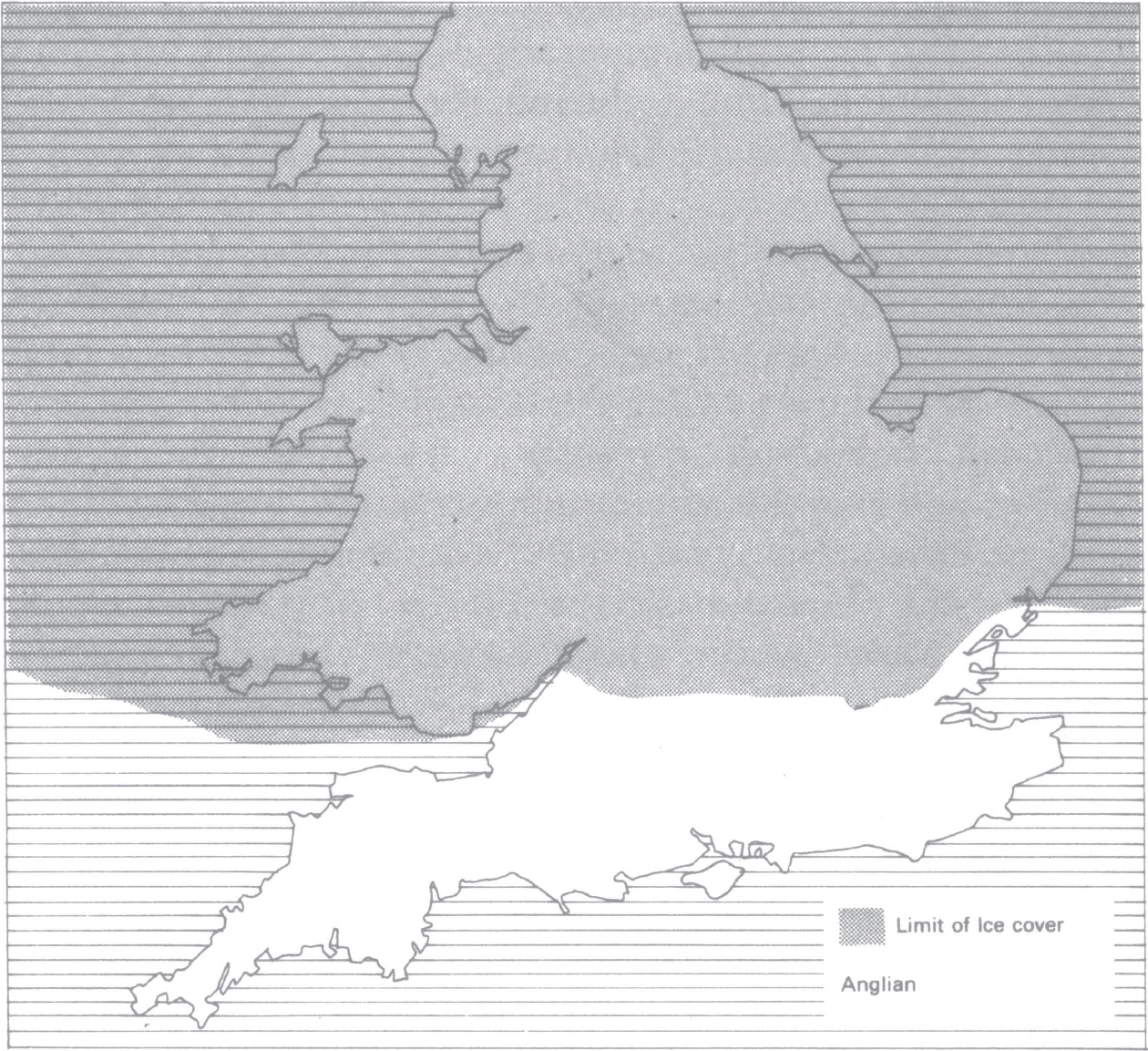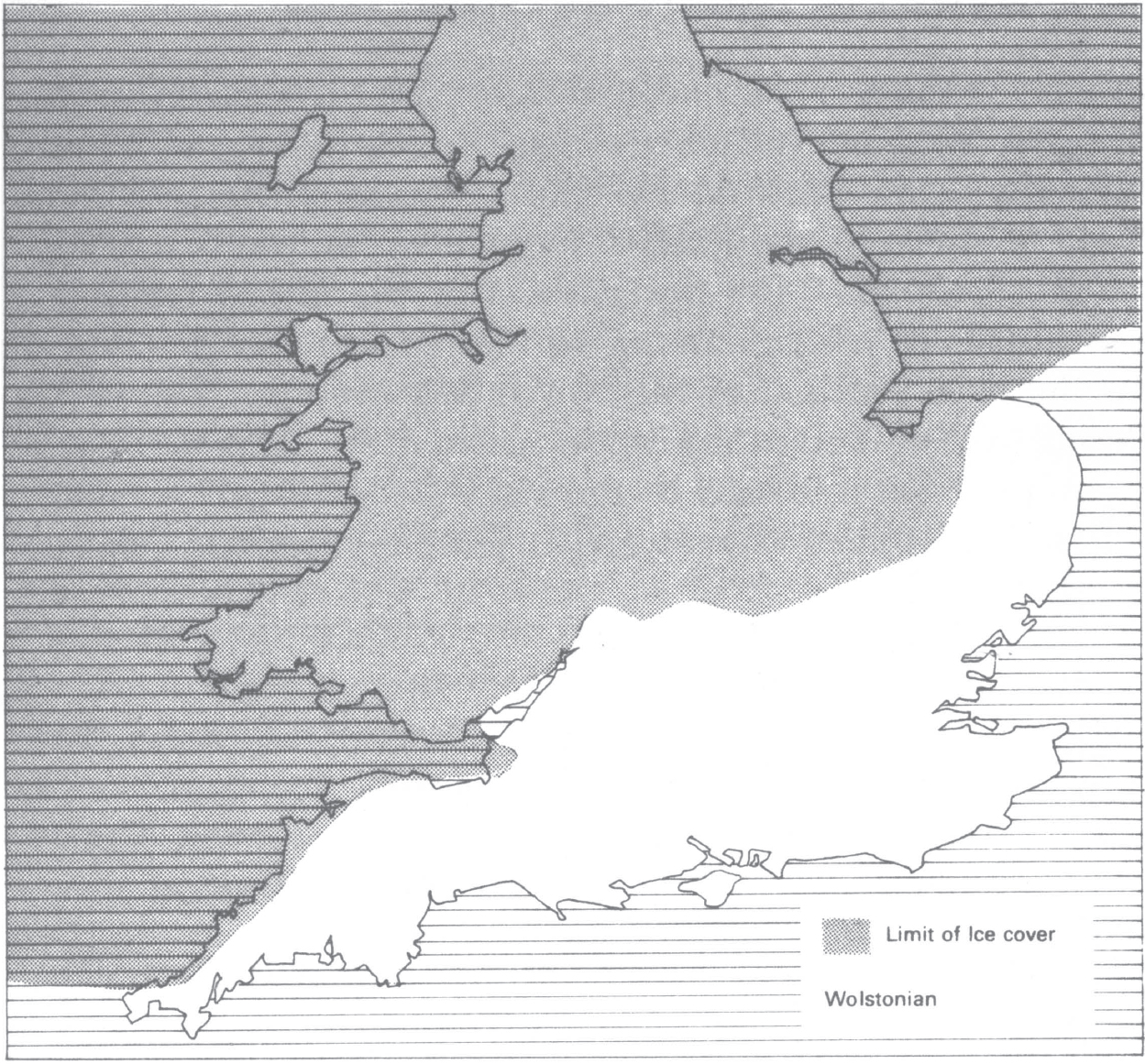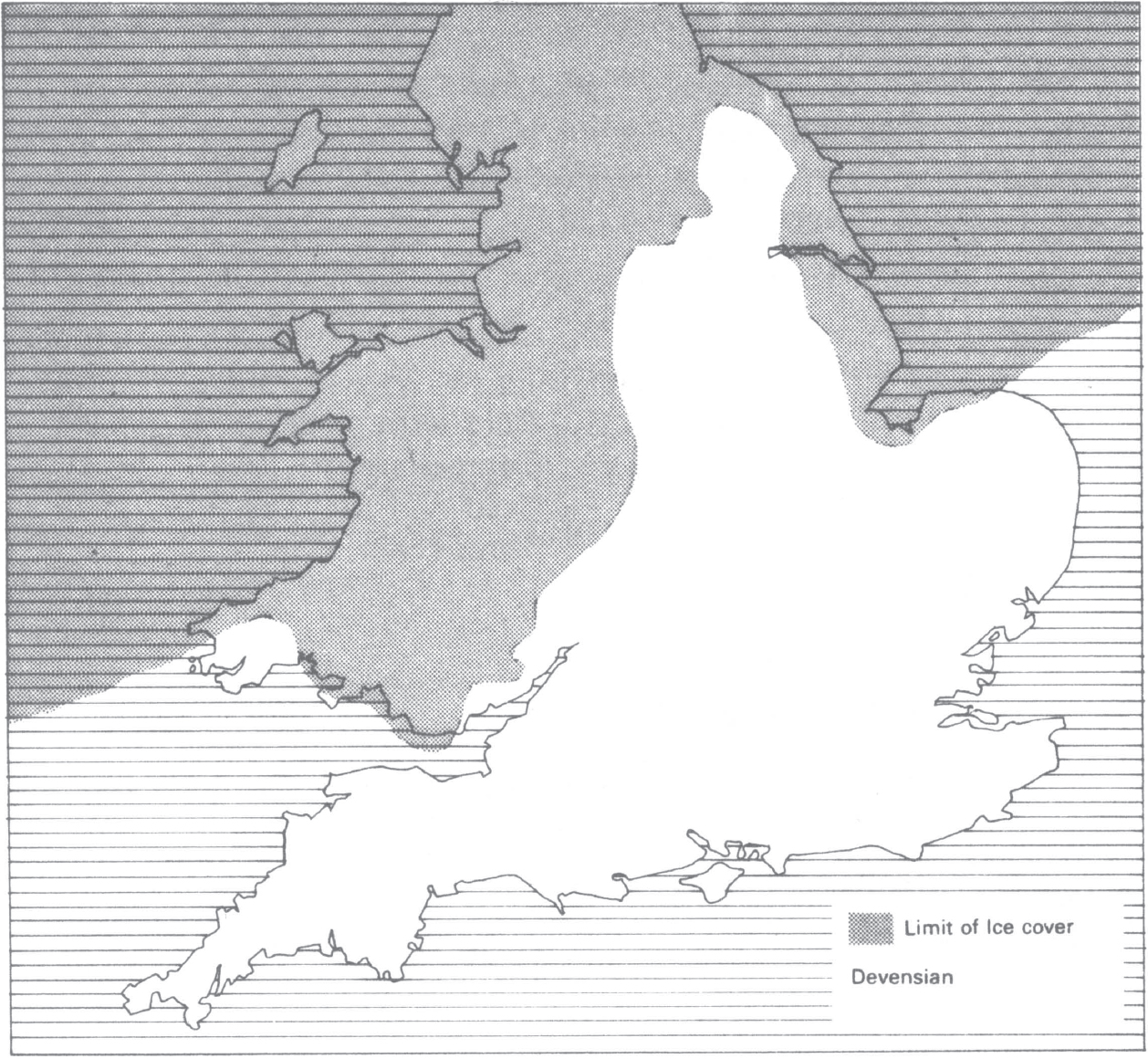
Полная версия
Collins New Naturalist Library
The history of the Pleistocene is, however, by no means the simple and clear cut sequence as might appear from the basic pattern. During glaciations the edges of the ice sheets advance and retreat to different extents and in different places, and during interglacial periods they re-advance from place to place and retire again in an unending chain of fluctuations that bring variations in topography, climate, flora and fauna. Furthermore, the sequence worked out for the glaciations of the Alps may not correspond exactly with those found elsewhere.
Geologists of many lands studying the glaciations and alternating interglacial periods of the Pleistocene in their own countries have gone deeply into the problems of correlating their local findings with the basic alpine pattern. A general measure of success has been achieved in this though much detail remains obscure, and the sequences in Scandinavia and northern Europe and in North America are found to correspond reasonably closely. They are, as well, found to correspond with the pluvial sequences found in land further south which, though never covered with ice sheets, experienced periods of high rainfall when the ice held more northern latitudes in its grip.
Although the pattern of successive glaciations in the Alps corresponds roughly with that of other parts of Europe and elsewhere, it is in some ways a special case. Even at the maximum of glaciation when a continuous sheet of ice blanketed northern Europe and Asia and covered the British Isles and the site of the North Sea, the ice cap over the Alps was separate and not continuous with the great ice sheet. The causes of the glaciations were similar for both regions but the effects were subject to local variations; consequently the nomenclature for the Alpine glaciations is now applied less uniformly to those of regions further north, including the British Isles.
The difficulty of making exact correlations between Pleistocene events in different places has been resolved by classifying them according to local stratigraphy. Pleistocene deposits, both those of glacial and interglacial stages, are not continuous, and the geologists have to put together the history of the epoch from the examination of scattered and limited samples from many different places. The glacial and interglacial stages are named after the places where well-known deposits of each stage have been studied, and consequently the nomenclature for north western Europe differs from that for the Alps, and from that for the British Isles. Thus the last or Würm glaciation of the Alps corresponds to the Weichselian glaciation of north-western Europe, and the Devensian of the British Isles.
In the British Isles many of the typical pleistocene sites are found in East Anglia and take their names from nearby towns and villages of Norfolk, Suffolk and Essex. The last glaciation however takes its name from the Devenses, the ancient British tribe that lived over 50,000 years later in the area including Four Ashes in Staffordshire, the typical site.128 The succession of deposits is not complete, so that information is lacking about the earliest Pleistocene, and for a period of about a million years in the middle Pleistocene. In spite of these gaps the deposits indicate alternating colder and warmer phases but give no unequivocal evidence of glaciation, with ice sheets covering much of the country, until comparatively late in the epoch when ice cover reached its maximum during the Anglian glaciation, corresponding with the Elster glaciation of northwest Europe and the Mindel of the Alps.
Conditions immediately after the end of the Pliocene, some two to two-and-a-half million years ago, are imperfectly known but there appears to have been a cold stage at first, represented by the Nodule Bed at the base of the Red Crag deposits of East Anglia. A gap in the record of nearly half a million years is then followed by an alternation of two warm and two cold stages represented by pre-glacial deposits of the lower Pleistocene. These are the Ludhamian (Ludham, near Norwich) warm, Thurnian (river Thurn, Norfolk), cold, Antian (river Ant, Norfolk) warm, and Baventian (Easton Bavents, near Southwold, Suffolk) cold. At the end of the Baventian stage another gap in the record lasting about a million years is followed by the warm Pastonian stage (Paston, near Cromer, Norfolk), the first stage of the middle Pleistocene, about half a million years ago.
The following Beestonian (Beeston, near Dereham, Norfolk) was the first cold stage of the middle Pleistocene and was succeeded by a warm stage, the Cromerian (Cromer, Norfolk), which lasted until the onset of the great glaciation over 450,000 years ago. This, the Anglian glacial stage (East Anglia), lasted between fifty and sixty thousand years and covered the whole of the British Isles as far south as the Thames with a sheet of ice that produced the greatest glaciation in the whole of the Pleistocene. When the Anglian stage came to an end the land was free of ice for about 185,000 years during the temperate Hoxnian stage (Hoxne, on the Suffolk–Norfolk border near Eye and Diss); in this stage the temperature was at times higher than that of the present day.
The next glaciation, the Wolstonian (Wolston, near Coventry, Warwickshire) lasted some 60,000 years from about 240,000 to 180,000 B.P. The ice cover did not extend as far south as in the Anglian stage; the ice edge ran south from northern Norfolk and then west across the midlands to the mid Welsh border, thence turning south to reach and follow the north coasts of Somerset, Devon and Cornwall. The succeeding Ipswichian (Ipswich, Suffolk) temperate stage lasted about 60,000 years until about 120,000 B.P. when the cold returned with the onset of the last, Devensian, glacial stage in which the ice covered Scotland, northern England, Wales, and most of Ireland. A large area of the midlands and east Yorkshire was thus free from ice cover, though the ice covering the North Sea encroached on the east coast as far south as Norfolk. The ice of the Devensian stage melted comparatively quickly some twelve thousand years ago so that before 10,000 B.P. the post glacial or Flandrian temperate stage was established, which extends to the present day; it takes its name from the transgression of the North Sea over the former dry land bordered by England and Flanders, when the sea level rose as the water from the ice returned to the sea.

Fig. 3. Limit of ice covering during (a) the Anglian, (b) the Wolstonian and (c) the Devensian glaciations.


In all the glacial stages there were at least two maxima of cold separated by less cold interstadial intervals, and similarly in the interglacial stages the climate fluctuated between cold, temperate, and warm. The beginnings and ends of the glacial stages were gradual, so that as the ice retreated after a glaciation the land was at first polar desert becoming steppe or tundra as the temperature rose; it was then invaded by open boreal forest with birch and pine dominant, which in turn was replaced by dense deciduous forest with alder, oak, ash and other broad-leaved trees. As a glacial stage approached the succession was reversed.
Epoch British Isles Climate Holocene Flandrian Temperate Upper Pleistocene Devensian Ipswichian Wolstonian Glacial with permafrost Temperate Glacial with permafrost Middle Pleistocene Hoxnian Anglian Cromerian Cromerian Cromerian Temperate Glacial with permafrost Temperate Cold with permafrost Warm Lower Pleistocene (Gap) (ca. 1 M. years) Cold with permafrost Temperate Cold Temperate Baventian Antian Thurnian Ludhamian (Gap) (ca. 1/2 M. years) Pliocene WaltonianFig. 4. Stages of the Pleistocene in the British Isles.
Apart from the climatic changes correlated with the glaciations and producing their advances and retreats, there were during the Pleistocene great changes in the level of the sea in relation to the land. The enormous masses of water withdrawn from circulation and locked up in the form of ice caused a fall in sea level of many hundreds of feet – indeed, it is reckoned that if all the ice even now in the form of glaciers and ice-caps were to melt the level of the sea would rise about three hundred feet.155 On the other hand the land is depressed towards sea level during glaciation by the sheer weight of ice resting upon it. At the same time there has been throughout the Pleistocene from time to time a slow upraising or lowering of the land, the eustatic movements of the tectonic plates.
An important consequence of these changes in sea level, whether caused by withdrawal of liquid water or by movement of the land, was that the British Isles were periodically part of the continent of Europe so that they shared its fauna and flora. Thus the bed of the southern part of the North Sea has for long periods been dry land, and the final opening of the Straits of Dover did not come about until some seven thousand years ago. One cannot help wondering whether this was a sudden dramatic happening in some furious equinoctial gale when low atmospheric pressure and a high spring tide combined with a surge such as those that have brought disastrous floods to East Anglia in recent times, broke the crumbling barrier and sent the waters of the North Sea pouring over into the English Channel – or whether an unusually high tide crept over a low dune between the salt marshes on each side so that the waters met and mixed with so little fuss that no one would have noticed.
The connection with the continent facilitated the return of the flora and fauna after it had been exterminated by each glaciation. At the time of the greatest glaciation some 450,000 years ago an unbroken sheet of ice covered the whole of northern Europe, including the British Isles, except southern England south of a line joining the Thames to the mouth of the Severn.61 The part left free of ice was deeply covered with winter snow, and the sea was full of floating ice. It is doubtful if any of the flora or fauna was able to live there; certainly no mammals could survive, and consequently our present fauna must have arrived after the ice of the great glaciation retreated.
Subsequent glaciations were less extensive so that the midlands as far north as York and the southern part of Ireland were free of ice and provided a possible habitat for those species that could withstand the arctic or subarctic conditions. The changes in flora and fauna are sometimes spoken of as retreats to more congenial climates in the south during the glaciations – the distribution of the plants and animals retreated, but there was no physical movement of individuals, they were merely killed. The return during interglacials was different; the flora gradually spread in by the usual manner of seed dispersal, but the animals and especially the mammals did move in ‘on the hoof’, not as mass migrations but in the course of populations extending their ranges under pressure of numbers as new habitats became available.
The amount of extermination among the mammalian species even in the last glaciation, which did not blanket the whole of the British Isles and ended some twelve to ten thousand years ago, is shown by comparing the 167 species of land mammal now living in western Europe with the 41 of Great Britain and the 21 of Ireland.151 Our fauna is not so much ‘impoverished’ as incomplete; there was not a long enough period of time before the breaching of the Straits of Dover for more species to extend their range into the islands. As H. W. Bates, the naturalist of the Amazon and later for many years secretary of the Royal Geographical Society, said in 1878, the British Isles are ‘a half starved fragment of the Palaearctic’.18
Many methods are now used for dating the events of the Pleistocene: geological methods such as the study of varves, the annual variation in the composition of deposits giving laminated sediments in freshwater lakes; investigation of the palaeomagnetism of rocks; and chemical methods such as radio-carbon dating of organic material derived from living organisms, and potassium-argon dating for older rocks. But in tracing the changes in the composition of the flora and fauna the discovery and study of the fossil or subfossil remains of the plants and animals themselves provides the most important evidence. If the horizons in which mammalian remains are recovered are accurately recorded it is possible to know the composition of the fauna from time to time, and to infer much about the conditions of the environment – when, for example, hippopotamuses lived in the Thames before the Devensian glaciation the climate was, presumably, much warmer than at present.
On the other hand the presence of various species of elephant need not of necessity imply that the climate was warm; the order Proboscidea, now reduced to only two species facing extermination in the not too distant future, was once numerous in species some of which were no doubt able to live in temperate or even cold climates provided there was sufficient vegetation for their food – it does not follow that all were warm climate creatures because their living relatives are. Indeed the mammoth, which was clothed in a warm coat of shaggy hair, was an inhabitant of cold regions. Similarly the woolly rhinoceros, which also had long hair, was present with the mammoth in the last cold interstadial of the Devensian glaciation.155 But hair on rhinoceroses does not imply that the animals live in cold climates for the hairiest of the living species, the Asiatic two-horned rhinoceros, lives in tropical south east Asia.
The hair sticking to the frozen remains of mammoths found in Siberia is red, but may have been darker or brown in life, for the pigments in long-preserved hair, especially when buried, undergo a change towards an auburn red – the hair of Egyptian mummies often has this tinge. The hair of Ben Jonson, who died in 1637, was found to be red when his skull with hair still attached was exposed in 1859 during the reburial in Westminster Abbey of the remains of John Hunter, the surgeon and anatomist.26 When the skull of Sir Thomas Browne, who died in 1682, was exhumed in 1840 the hair associated with it was ‘of a fine auburn colour’; before it was re-interred in the chancel of St Peter Mancroft, Norwich, in 1927 it was examined at the Royal College of Surgeons by H.L. Tildesley,144 who remarked that ‘hair of persons long buried is commonly found to have acquired a reddish tinge, whatever the original shade.’
Our most detailed knowledge of the composition of the flora and the nature of the climate, at different times during the Pleistocene is, however, derived from the study of fossil pollen, a technique now known as palynology. In addition, a study of peat, freshwater and marine molluscan shells, and of insects, especially the wing covers of beetles, has thrown much light on the changes in climate.
The outer layers of a pollen grain are made of the substance sporopollenin which, unlike the inner cellulose layers, is extremely resistant to the action of chemical changes so that pollen grains are almost indestructible by natural agencies. Vast quantities of pollen released by plants, and especially those species that are wind-pollenated, became mixed with the soil and waters and included in the deposits and sediments. The surface of pollen grains is thrown into a great range of shapes and patterns that are characteristic of, and identify, the different species; the presence and relative quantities of pollen in any sample of Pleistocene deposit therefore show the presence and relative abundance of the plants from which they were derived. So, for example, a predominance of conifer pollen indicates a cool climate, and a preponderance of oak pollen points to a milder climate. There are, naturally, difficulties in using pollen analysis; pollen can be carried great distances by the wind, and the indestructible nature of the pollen coat itself allows pollen from old deposits to be washed out and included in younger ones. Palynology has nevertheless proved to be one of the most valuable tools in reaching an understanding of the changes during the Pleistocene.
Palynology was born in Denmark and was developed with great success in the British Isles by Sir Harry Godwin and his pupils at Cambridge so that the history of the British flora, and with it that of the environmental ecology, is now better known than that of any other area of similar size.67 The earlier work of Zeuner155 on the climate, chronology, and faunal successions of the Pleistocene, not only in the British Isles but throughout the world, was extended in great detail by Charlesworth twelve years later.33 This immense work summarises and reviews world-wide research on the Pleistocene up to 1956, and discusses all the different theories that have been put forward to explain its occurrence and the fluctuations that took place during it.
Charlesworth points out that terrestrial causes such as deformations of the crust of the earth are not sufficient to have brought about glaciations. He favours the theory that long-term variations in the amount of solar radiation reaching the earth were the probable cause, though it may not be possible to prove their occurrence by direct observation. This hypothesis was first made by Simpson,130 who suggested that an increase in solar radiation by raising the world temperature intensified the atmospheric circulation, and brought about glaciation by augmenting the amount of cloud and precipitation. Charlesworth points out that glaciation was probably produced by a number of factors, of which variation in solar radiation was only one, and that meteorological, geological, and astronomical changes ‘all interacting and so delicately balanced that a slight change, such as would be undetected by less than a century of acute observation, might induce great effects.’
As an outcome of recent studies it is now widely accepted87 that major glaciations are due primarily to the positions of the continents resulting from continental drift and the movements of the tectonic plates. Ice ages can only occur when there are land masses in high latitudes on which ice and snow can accumulate – the condition of the earth today, with an Antarctic continent and an Arctic sea surrounded by land. With the continents in these positions the ‘Milankovitch effect’ comes into operation, and small regular changes in the earth’s orbit and orientation towards the sun cause the rhythmic alternation of glaciations and mild interglacial stages through the changes in the amount of heat received by high latitudes. The ‘wobbles’ in the earth’s movements are astronomically predictable, and consequently the sequence of ice ages can be shown to have occurred many times, probably twenty or more, during the Pleistocene.19 Predictions warn that our present interglacial may not last more than another thousand years until it begins to decline into the next glaciation, which, at its peak after some 20,000 years will be more severe than the Devensian.
‘Little ice ages’, such as the cold period that lasted from about 1650 to 1850, occur at more frequent intervals. They are caused by a temporary decline in sunspot activity combined with an increase in terrestrial volcanic activity, which produces a veil of dust in the atmosphere that reduces the solar heat reaching the earth. Major glaciations, however, only occur when the earth periodically ‘wobbles’ to produce the Milankovitch effect.
Whatever the causes of glaciation may be, we may take it as certain that the present mammalian fauna of the British Isles originated after the end of the great Anglian glaciation nearly half a million years ago. Furthermore it seems probable that few species of mammal survived the Devensian glaciation, during which ice covered the northern part of the islands, and the southern parts were subjected to a severe periglacial climate with permafrost producing frost-tundra having little plant cover. At the end of the Devensian the succeeding Flandrian post-glacial stage saw the establishment of the mammalian fauna as we see it today, although it is now reduced by the loss of several species that have been exterminated by man.
During the last hundred and fifty years a host of geologists and palaeontologists, amateur and professional, has collected great quantities of mammalian fossils from the Pleistocene deposits, and has worked on the difficult problems of deducing the composition of the faunas of the various stages. The earlier workers did not appreciate the importance of recording the exact horizons at which they found the fossils, and consequently their specimens give less information than those collected by later workers who adopted a stricter discipline. In addition, much material collected on sea beaches came from strata exposed in the cliffs above, and cannot be accurately assigned to the horizon from which it is derived. Similarly fossil and subfossil bones found in caves have frequently been excavated without recording the precise horizon from which they came. The stratigraphy of cave deposits is complicated by the way in which the fossils were included. The remains from which the fossils are derived were often washed in by floods, or carried in by predators, so that specimens of different provenance are confusingly mixed.
The researches of many workers nevertheless combine to give a picture of the succession of faunas that can be accepted with confidence as reasonably accurate. The results are widely scattered throughout a vast literature, but the Monographs of the Palaeontographical Society120 in which large numbers of mammalian fossils from the Pleistocene have been described and illustrated during the last hundred and thirty years, deserve special notice. Many authorities, too, have gathered the available information together to give an account of the Pleistocene faunas, one of the earliest being Buckland’s ‘Reliquiae Diluvianae’27 published in 1823, which described fossils from caves and ‘diluvial gravel’ as evidence of ‘the action of a Universal Deluge’. A later classic is Owen’s ‘History of British Fossil Mammals and Birds’ published in 1846,118 and from the nature of the material available necessarily dealing mainly with Pleistocene faunas. In contrast a modern synthesis based on the results of researches supported by the latest technologies such as Stuart’s review,136 shows the complexity of the succession of faunas, and the differences in fauna with the alternation of cold and warm, glacial and interglacial stages. The following summary of events is based in part on this important work.
The deposits of the lower Pleistocene are the strata of the Red Crag, with the Norwich Crag lying above them, that cover much of East Anglia. The oldest part of the Red Crag is the Nodule Bed found at its base in several places. All are marine deposits laid down when the sea level was considerably higher than at present, sometimes as much as forty feet. The fossil bones of land mammals found in them must therefore represent animal carcases that were washed into the sea, especially by rivers in flood, and consequently may not be a fair sample of the contemporary fauna. The Red Crag Nodule Bed, however, is derived partly from the breakdown of older rocks and contains the remains of their fossils in addition to its own contemporary ones; some are derived from Pliocene or older formations and are much worn and polished by wave action.


